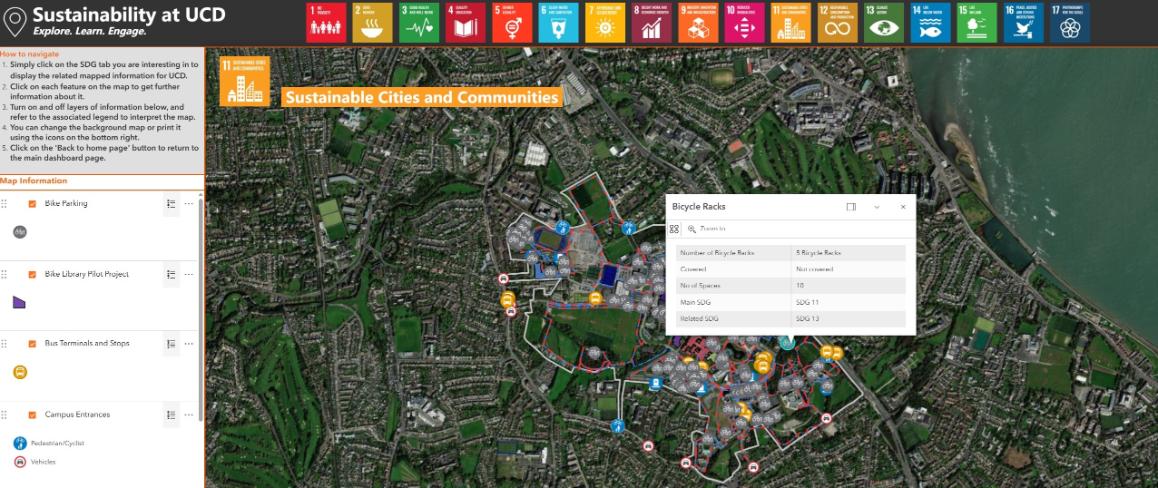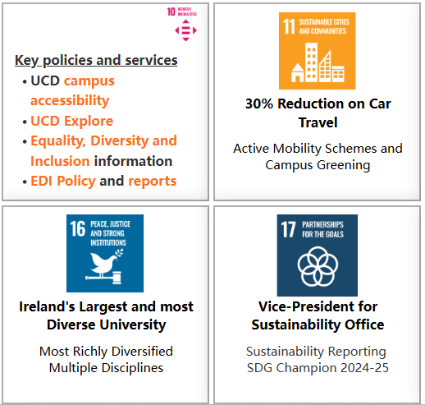UCD Sustainable Action: A conversation with Prof. Ainhoa González Del Campo
The UCD Sustainable Action: Collaborative Mapping and Learning project, led by Professor Ainhoa González Del Campo (School of Geography), was inspired by the need to take stock of what UCD is currently doing to promote sustainability on campus, and the opportunity to raise awareness and encourage engagement with such initiatives. A paper on the UCD Sustainable Development Goals (SDGs) Dashboard (which was co-created as part of the project) has been published in the International Journal of Sustainability in Higher Education.
In a recent conversation, Professor Ainhoa González Del Campo talked us through the project and how it's advancing both teaching and learning excellence and sustainability goals at UCD.
Your recent paper makes a compelling case for mapping sustainability efforts at universities. How do you see this work contributing to the theme of Education for Sustainable Development?
The dashboard gathers university policies, services and initiatives linked to the United Nations’ Sustainable Development Goals providing a tangible, visual and accessible opportunity to interact with the SDGs There is a lot of talk about sustainability in universities because of our role in educating and capacitating future leaders and individuals to leave and act more sustainably, and also because of the potential of our research to help address our environmental and social challenges. There are metrics that measure how sustainable universities are, but I always thought that we were missing out by looking at the university as a whole when reporting on sustainability aspects as we did not have a clear picture of what parts of the university function more sustainably, what are the specific teaching and research efforts within Schools, or what parts of campus provide sustainable infrastructure. So, I wanted to develop an interactive inventory that tangibly addressed these questions. And that is how I came up with the idea of the dashboard and of mapping all services and initiatives on campus.
This dashboard is the first of its kind in Ireland, and I think it is very important in expanding the understanding of what Higher Education Institutions are doing towards sustainability. Among other things, it supports students’ awareness and provides an insight into ongoing sustainability research projects, it enables increased engagement with sustainability infrastructure on campus and provides information on who to approach to find out more. It also supports teaching and learning in the classroom by challenging students to think critically about what is being done and what else can be done, and helps identify existing knowledge and action gaps that can be addressed in research projects.
I know that a number of modules have integrated the dashboard into their teaching. For example, as part of the module ‘Mapping a Sustainable World’, students carry out mapping activities to develop practical skills. The data they collect is subsequently used, where appropriate, to update the dashboard. The modules ‘Introduction to Sustainability’ and ‘Education for a Sustainable Future’ also make reference to it, to link global environmental issues to local actions. So overall, I think the dashboard provides a very robust tool to meaningfully support Education for Sustainable Development.

Building on the research in your paper, you co-created the Sustainability Dashboard. For those who haven't seen it, could you describe what the dashboard does and how it could help students and staff?
The dashboard centralises all the sustainability-related information for UCD. This includes policies, strategies, services, infrastructure, research, and student-led initiatives. The available resources are grouped according to their relevance to an SDG, so the user can interrogate what are the policies, services and initiatives for SDG3 on health and wellbeing or SDG13 on climate action, for example.

I think the fact that the dashboard is based on Geographic Information Systems (GIS) to gather data and ultimately visualise and interact with these data via online maps, makes it more accessible to the campus community. They can search for specific infrastructure such as water fountains, gender neutral toilets or electric vehicle charging stations, and visualise their locations. They can identify research groups or student societies working on specific sustainable-related research topics and access their contact details. They can interrogate the energy efficiency of buildings or how many solar panels are installed on campus, and get insights into renewable energy outputs. They can learn about the flora and fauna species present across the different woodland and grassland areas. And in doing the above, they can identify areas that are missing information or indeed parts of campus that require dedicated efforts to, for example, improve existing sustainable infrastructure. This also helps UCD Estates and Services in their job.
As it provides a one-stop shop for sustainable information on campus, I think it can support students' understanding of what UCD is doing towards sustainability and how they can get involved. Similarly, it can help staff become more engaged and develop teaching and learning, and even small dissertation topics, around the information available, using the campus as a sustainability living lab.
Bringing a project like that from a research concept to a real tool requires significant support. Could you speak about the role SATLE funding played in that journey?
The idea for the project had been brewing in my mind for some time, and I always wanted to do something like this. The SATLE funding provided an opportunity to turn the idea into action. I think that applying for the SATLE proposal also gave the project a definitive purpose. It also gave me some funding to remunerate the students who so kindly and eagerly contributed to the project. Notwithstanding these benefits of SATLE funding, the project required substantial investment of my time and effort in developing the dashboard.
The project and research output were a 'co-creation' with students and staff. From a teaching and learning perspective, what did you learn from that collaborative process?
Student participation was indeed integral to the success of the project. I reached out to the students even before I applied for SATLE funding, so it was a student-staff partnership from day one. I did not want to deliver a teaching and learning tool for students, I wanted to develop something with the students for their learning journey. I also wanted to make sure that academic staff and Estates and Services were involved from the outset, to go beyond a teaching and learning tool and develop something that was to be meaningful and useful for the entire UCD community. I want to acknowledge that Estates and Services were very kind with their time and provided a lot of data and information that facilitated some of the project tasks. Every project partner brought something valuable to the project, really. I was very lucky to get a large team involved in developing and delivering the dashboard. Their enthusiasm and support were fundamental to the project’s success. And I am very grateful to everyone involved.
I think it is important to highlight the extraordinary engagement of students, with additional students engaging and volunteering as the project progressed. They encouraged colleagues to respond to the project survey, which is part of the reason why we gathered so many responses! And they also analysed those responses and produced a ‘wish-list’ of aspects to include in the dashboard. They carried out data collection throughout the campus and painstakingly digitised PDFs into a GIS-compatible format. They quality checked the data and curated it so I could incorporate it consistently into the dashboard. They were amazing, really. Also, the research paper that you mentioned in the first question was co-written in collaboration with the students involved. They wrote about their individual contributions to the project, and I was able to stitch these together. I think there was a really good dynamic in the project, and its sustainability remit and local scope and their involvement gave students a sense of ‘belonging’.
engagement of students, with additional students engaging and volunteering as the project progressed. They encouraged colleagues to respond to the project survey, which is part of the reason why we gathered so many responses! And they also analysed those responses and produced a ‘wish-list’ of aspects to include in the dashboard. They carried out data collection throughout the campus and painstakingly digitised PDFs into a GIS-compatible format. They quality checked the data and curated it so I could incorporate it consistently into the dashboard. They were amazing, really. Also, the research paper that you mentioned in the first question was co-written in collaboration with the students involved. They wrote about their individual contributions to the project, and I was able to stitch these together. I think there was a really good dynamic in the project, and its sustainability remit and local scope and their involvement gave students a sense of ‘belonging’.
What advice would you give a colleague who is inspired by this and has an idea for their own innovative teaching and learning project at UCD?
My advice to colleagues is to have a very clear idea of your teaching and learning project’s output and to engage the students from the very beginning. It is important to ensure they are part of the process, as this will not only bring in enthusiasm and a willingness to help, but also ensure that whatever the project is trying to achieve, it includes their opinion and addresses their concerns. This will help guarantee that your project output or outputs are meaningful for the students and the wider academic community.
I would also advise that colleagues consider what will happen to the project after the funding ends and how to maintain any resources/activities created by the project. In our case, ensuring that the dashboard data is kept up to date requires dedicated time and effort, but I no longer have the funding for specific resources to do this. So, we built a practical exercise in the ‘Mapping a Sustainable World' module, for example, where students collect campus data (recently, flora and fauna sightings), which I then curate and use to update existing datasets or add new ones to the dashboard. We have also collaborated with undergraduate and postgraduate research projects to update complex datasets (e.g. habitats) and create new data layers (e.g. drainage). These initiatives help keep the dashboard updated and relevant. I would also like to note that the UCD Sustainability Unit has been very helpful, and I cannot thank them enough for giving the dashboard a home on their website, and their ongoing support is helping ensure that the dashboard remains alive way beyond SATLE funding end dates.
UCD Teaching & Learning would like to thank Professor Ainhoa González Del Campo for taking the time to speak with us about the project. Find out more about the UCD Sustainability Dashboard and access other UCD sustainability resources.
